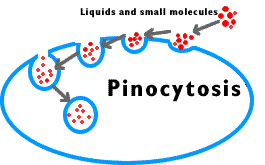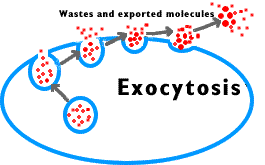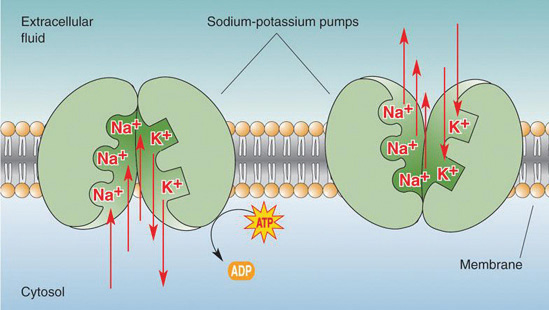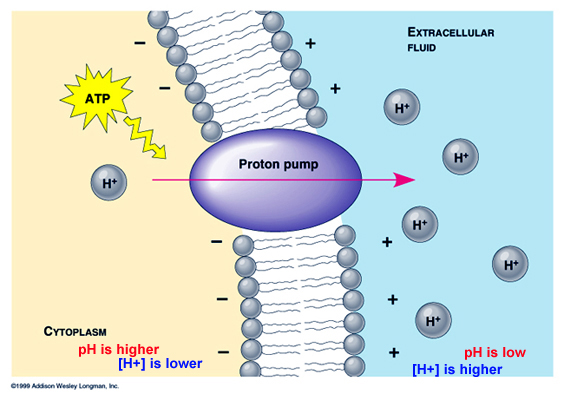Cell Transport, Part II
|
Old Books (5th Edition "Nemo" Books)
|
New Books (6th Edition Books)
|
|
Read pp. 114-123.
|
Read 113- 122.
|
Active Transport: requires large amounts of energy (ATP) to 'pump' materials against force of diffusion (low to high).
A. Endocytosis (bulk passage): move large polar molecules.
This action requires energy input (ATP) by cell.
Animation:
[Receptor-mediated
Endocytosis]
Types of Endocytosis:
1) Phagocytosis:
cell eating of large particles by formation of vacuoles.

2) Pinocytosis:
cell drinking, liquid material brought into cell by vacuole formation.

B. Exocytosis:
materials discharged from cell (vacuole passes plasma membrane to dump contents out of cell).

C. Sodium-potassium pump. Moves 3 Na
+ out of cell & 2 K+ into cell. Both Na+ and K+ are moved from low to high concentration.
Animation: [Sodium/Potassium
Pump#1] [Sodium-Potassium Pump #2] [Nerve Action Potential Animation]
[Na+/K+ Pump & Cotransport Online Lab (BioCourse.com)]

D. Proton pump (chemiosmosis): Uses ATP. moves protons (H+) out of cell from low to high concentration.
Animation: [Proton Pump (McGraw Hill)]

E.
Cotransport: Movement of amino acids (aa) and sugar into cell from low to high concentration. Protons from proton pump provide energy to move the amino acids an sugar into the cell.

Animation: [Cotransport]
Animation: [Cotransport] (McGraw Hill]
Online Reviews of Passive & Active Transport:
A. Passive Transport
Diffusion
Osmosis
Osmosis
in an Isotonic Environment: (www.cat.cc.md.us) -
Osmosis
in a Hypertonic Environment:
Osmosis
in a Hypotonic Environment:
Facillitated
Diffusion (no ATP used......from high to low concentration)
Transport
(In french, but does a good job illustrating diffusion, passage through protein
channels, cotransport, Na/K pumps, endocytosis & exocytosis.)
B. Active Transport
Active
Transport: (McGraw-Hill) - 4 Animations &
Audio of CoTransport, Na/K Pump, Endocytosis & Exocytosis, and Proton
Pump.
Sodium/Potassium
Pump: (No text with it but a good animation
of this important form of Active Transport)
CoTransport
(passage of Na into the cell helps bring Glucose (G) in too!)
Sodium/Potassium
Pump combined with Cotransport (The sodium/potassium pump is often
coupled with Cotransport to power the active transport of glucose into a cell)
Pinocytosis:
Phagocytosis:
Shows both an animation as well as 2 short movie clips of amoebas ingesting
other organisms via phagocytosis.
Receptor-mediated
Endocytosis: The molecule to be moved into the cell must match up
with a receptor on the membrane surface to be moved in.
Exocytosis:
Exocytosis:
(BBC Education)
Slichter





